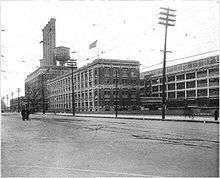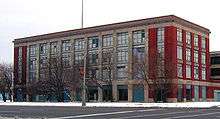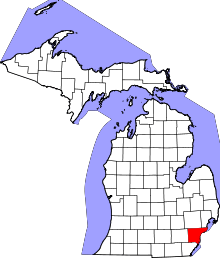Highland Park Ford Plant
Coordinates: 42°24′38″N 83°05′58″W / 42.410509°N 83.099554°W
|
Highland Park Ford Plant | |
 The Highland Park plant in 1922 | |
  | |
| Location |
91 Manchester Avenue at Woodward Highland Park, Michigan |
|---|---|
| Built | 1910 |
| Architect | Albert Kahn; Edward Gray |
| NRHP reference # | 73000961 |
| Significant dates | |
| Added to NRHP | February 6, 1973[1] |
| Designated NHL | June 2, 1978[2] |
| Designated MSHS | April 17, 1956 |
The Highland Park Ford Plant is a former Ford Motor Company factory located at 91 Manchester Avenue (at Woodward Avenue) in Highland Park, Michigan. It was the second American production facility for the Model T automobile and the first factory in history to assemble cars on a moving assembly line. It became a National Historic Landmark in 1978.[1]
History
The Highland Park Ford Plant was designed by Albert Kahn Associates in 1908 and was opened in 1910. Ford automotive production had previously taken place at the Ford Piquette Avenue Plant, where the first Model Ts were built. The Highland Park Ford Plant was approximately 4 miles (6.4 km) northwest of the original Dodge Brothers factory who were subcontractors for Ford, producing precision engine and chassis components for the Model T. It was also approximately 1 mile (1.6 km) northwest of the former Brush-Maxwell plant, which later became the headquarters for the Chrysler Corporation.
The complex included offices, factories, a power plant and a foundry.[3] About 102 acres in size the Highland Park Plant was the largest manufacturing facility in the world at the time of its opening. Because of its spacious design, it set the precedent for many factories and production plants built thereafter.
On October 7, 1913, the Highland Park Ford Plant became the first automobile production facility in the world to implement the moving assembly line.[4][5] The new assembly line improved production time of the Model T from 728 to 93 minutes.[6] The Highland Park assembly line lowered the price of the Model T from $700 in 1910 to $350 in 1917, making it an affordable automobile for most Americans.[7] On January 5, 1914, Ford announced that factory wages would be raised from a daily rate of $2.34 (equivalent to $57 in 2017) to $5.00 (equivalent to $122 in 2017), and that daily shifts would be reduced from nine hours to eight.[8] After the increase in pay, Ford claimed that the turnover rate of 31.9 percent in 1913 decreased to 1.4 percent in 1915.[9] Ford offered nearly three times the wages paid at other unskilled manufacturing plants.[10]
In the late 1920s, Ford moved automobile assembly to the River Rouge Plant complex in nearby Dearborn. Automotive trim manufacturing and Fordson tractor assembly continued at the Highland Park plant. The 1,690 M4A3 Sherman tanks built by Ford from June, 1942 to September, 1943 were assembled in this factory, as well.
During the 1940s through 1960s, the Highland Park plant was a principal location for Ford U.S. tractor manufacture. In the 1970s, the Romeo, Michigan, plant increasingly displaced it for that role. By the mid-1990s neither plant was any longer producing tractors or tractor parts, as Ford had sold off its tractor and implement interests in stages during the 1990-1993 period.
As of 2011, it had been used by Ford Motor Company to store documents and for artifact storage for the Henry Ford Museum. A portion is also occupied by a Forman Mills clothing warehouse that opened in 2006.[11]
Current status
The Woodward Avenue Action Association has a purchase agreement with the complex's owner, National Equity Corp., to pay $550,000 for two of eight buildings at the historic Ford manufacturing complex: a four-floor, 40,000-square-foot administration building and the 8,000-square-foot executive garage near it. The center would include a theater with continuous videos, informational kiosks, interpretive displays on automotive history and a gift/coffee/snack shop. It could also be a place where visitors could pick up historical automotive tours, such as the current tour offered by the Woodward group, "In the Steps of Henry."[12]
In the media
The plant was used as a location for director Shawn Levy's 2011 Disney/Touchstone Pictures film Real Steel.[13]
Gallery
 Highland Park Ford plant, c. 1922
Highland Park Ford plant, c. 1922 Highland Park Ford plant, c. 1922
Highland Park Ford plant, c. 1922
 South side streetscape of the Highland Park Ford plant complex
South side streetscape of the Highland Park Ford plant complex Large building that is part of the Ford plant complex (now the Highland Park Industrial Center)
Large building that is part of the Ford plant complex (now the Highland Park Industrial Center)
See also
References
- 1 2 National Park Service (2007-01-23). "National Register Information System". National Register of Historic Places. National Park Service.
- ↑ "Highland Park Ford Plant". National Historic Landmark summary listing. National Park Service. Archived from the original on 2012-10-06. Retrieved 2008-06-27.
- ↑ "Ford Motor Company Highland Park Plant". National Scenic Byways Program summary listing. National Scenic Byways Program. Retrieved 2010-01-23.
- ↑ "Ford's Assembly Line Turns 100: How It Changed Manufacturing and Society". New York Daily News. October 7, 2013. Archived from the original on November 30, 2013. Retrieved August 27, 2017.
- ↑ "Preserve Ford Highland Park". Woodward Avenue Action Association. Archived from the original on November 17, 2015. Retrieved October 7, 2015.
- ↑ http://www.nps.gov/nr/travel/detroit/d32.htm
- ↑ William Wright. "Highland Park Ford Plant". Nps.gov. Retrieved 2013-12-09.
- ↑ Rosenthal, Phil (January 5, 2014). "Ford's Visionary Move to Raise Wages Has Lessons Today". Chicago Tribune. p. 1. Archived from the original on April 17, 2018. Retrieved April 17, 2018.
- ↑ Rosenthal, Phil (January 5, 2014). "Ford's Visionary Move to Raise Wages Has Lessons Today". Chicago Tribune. p. 2. Archived from the original on April 17, 2018. Retrieved April 17, 2018.
- ↑ "Archived copy" (PDF). Archived from the original (PDF) on 2013-09-03. Retrieved 2013-09-13.
- ↑ "Forman Mills discount clothing opens Highland Park warehouse store in former Model T factory". Model D. 8 August 2008. Retrieved 22 October 2011.
- ↑ "Ford's historic Michigan plant moves closer to reopening as tourist attraction". Autonews.com. 2013-07-15. Retrieved 2013-12-09.
- ↑ Hinds, Julie (October 1, 2011). "Michigan locations in 'Real Steel'". Detroit Free Press. Archived from the original on October 4, 2011. Retrieved October 4, 2011.
External links
| Wikimedia Commons has media related to Highland Park Ford Plant. |
- The Moving Assembly Line Debuted at the Highland Park Plant, Historic Sites, Heritage, Ford Motor Company official site.
- National Register of Historic Places Inventory - Nomination Form, May 1977.
- Ford's Highland Park plant a manufacturing pioneer, MotorCities National Heritage Area, Detroit News article, May 21, 2009.
- National Historic Landmarks in Michigan, Michigan Historical Center, State Historic Preservation Office, Michigan State Housing Development Authority.
- Ford search results - Historic Sites Online, Michigan Historical Center, State Historic Preservation Office, Michigan State Housing Development Authority.
